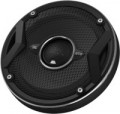Type
—
Broadband speakers. The simplest type of acoustics: one speaker is used to reproduce the entire frequency range. The advantages of such speakers are simplicity of design (as a result, low cost) and ease of installation. On the other hand, the sound quality of full range speakers is significantly lower than that of dedicated speakers (see below).
—
Component speakers. The most advanced type of car speaker: it has separate speakers for each frequency band (see "Number of bands"), which allows you to customize the sound of each speaker as you wish and provide high sound quality. If the latter is the main factor for you when choosing car audio, you should pay attention to component speakers. However such systems are not cheap, and their installation can be quite complicated due to the large number of speakers.
—
Coaxial speakers. A kind of compromise between component and full-range speakers: in such systems, small-sized tweeters and mid-range speakers are placed directly in front of the larger woofer cone, on the same axis with it. This design simplifies installation, reduces cost, and delivers better sound quality than full-range speakers. However this quality is still lower than that of component systems, and therefore “coaxials” are usually used either as rear speakers, or when for some reason (for example, due to cramped conditions) it is impossible to install a
...component speaker.
— Cabinet speaker. The speakers of such acoustic systems are housed in a separate cabinet(s). This greatly simplifies installation — you do not have to find speakers to fit existing niches or even cut these niches on purpose, as in other types of speakers. On the other hand, such acoustics take up more space in the cabin.
— Midrange speakers. As the name implies, such a speaker reproduces only the middle frequency band, "cutting off" the highest and lowest. Technically, it can be used as a separate speaker, but this is usually not justified. Therefore, in fact, mid-frequency acoustics are usually installed as part of a more advanced component-type system (see above).
— Twitter. A speaker designed to reproduce high frequencies. Due to specialization, it is not used separately, it is used in combination with a mid-frequency speaker to build component-type systems (see above).Frequency range
The total audio frequency range reproduced by all speaker speakers.
Obviously, this range should not be too narrow, so that the acoustics do not cut off the lower and/or upper frequency limits of the reproduced sound. At the same time, the human ear perceives sound within 16 Hz - 22 kHz, and it simply does not make sense to provide speakers with a wider frequency range. We also recall that in
mid-frequency acoustics and tweeters, reproducible frequencies are limited due to specialization (for more details, see "Type"). And the overall sound quality will depend not only on this indicator, but also on a number of other features.
Sensitivity
This parameter determines the volume of the sound of a particular speaker when a certain standard signal is fed to it. Typically, this is considered a 1 W signal with a frequency of 1000 Hz. The higher the sensitivity, the less the speaker is demanding on the power of the amplifier. So, it is believed that for acoustics connected directly to the car radio, the sensitivity should be 80 dB or more; for less sensitive systems it is recommended to use a separate amplifier.
External crossover
Crossover is part of acoustic system that divides the overall signal into separate frequency bands fed to the corresponding speakers (for more details, see "Bands"). All multi-band speakers (component and coaxial, see "Type") have their own crossover; it is usually located directly in the speaker body. However, in some models, usually the most advanced ones, the crossover can be made as a separate device, in its own body.
External crossovers are considered to provide better sound quality and introduce less distortion into it; in addition, they often provide the ability to fine-tune the sound.
Woofer size
Size of the low-frequency speaker(s) provided in the speaker system.
This size is specified only for models with separate bass speakers. In such acoustics, it is the LF emitter that is the largest (this is due to the physical characteristics of the bass range). Accordingly, the space occupied by the entire system is determined mainly by the diameter of the LF speaker. And since the power and richness of the bass also directly depends on the size of the emitter, then when choosing, you have to proceed from a compromise between the capabilities of the acoustics and the available space in the car.
Mounting depth
The mounting depth of car audio is, in fact, the size of the speaker in depth. Note that for component sets (see "Type") this parameter is given for the largest speaker, and for case models it is generally irrelevant.
The mounting depth, along with the diameter of the speaker (see above), determines the amount of space needed to mount the speaker — in this case, how deep a niche would be required for normal mounting. At the same time, the larger the speaker, the larger, usually, the installation depth. And with similar diameters of equal size, a more powerful model is likely to be more “deep”.
The smallest amount of space —
up to 15 mm deep — is required by some tweeters. A depth
of 16 – 30mm is normal for tweeters and very shallow for general range speakers, most of these models have a depth
of 30mm or more. At the same time, full-range speakers are usually "recessed" by
less than 60 mm, component systems — by
less than 90 mm, and
more depth may be required only for some coaxial and mid-range models and, oddly enough, tweeters.

